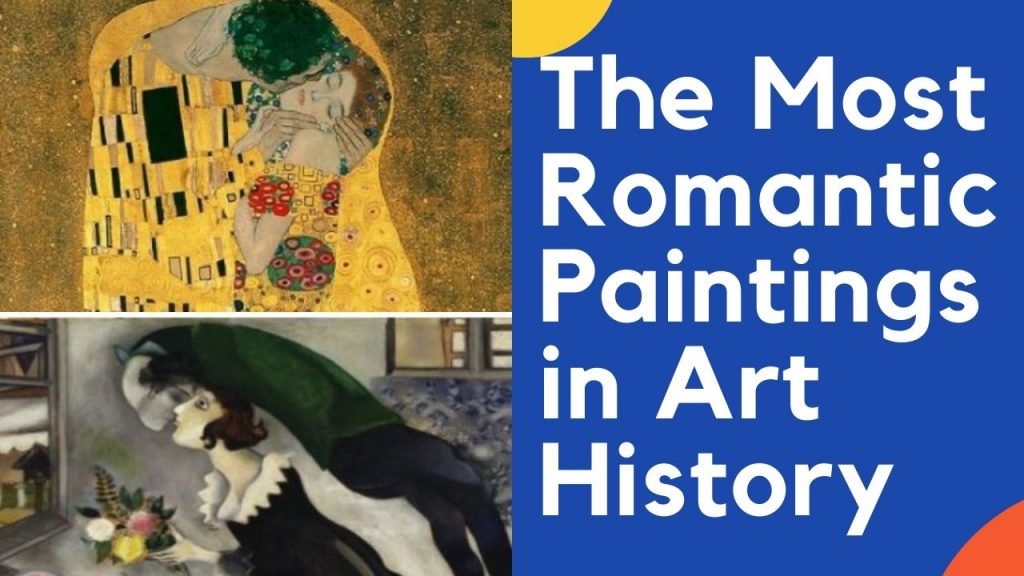In the big world of art, romantic paintings on canvas show feelings of love and passion. This article talks about the charm of romantic painting. It also gives ideas and tips for people who want to make their romantic paintings.
The Heart of Romantic Painting:
Romantic painting is all about showing deep emotions. Artists, following the ideas of Romanticism, put love and passion into their paintings. They create visual stories that touch our hearts.
History and Romanticism:
Romantic painting started in the late 1700s with the Romanticism movement. This movement wanted to express feelings and individual thoughts, going against the cold and logical ideas of the time. Artists like Eugene Delacroix and Caspar David Friedrich laid the foundation for romantic art.
Colors, Techniques, and Romantic Art:
Romantic art uses rich colors and special techniques. Artists use warm colors like red, purple, and pink to show the strong emotions of love. The method is not just about how the brush moves but also about capturing a moment, making it a big part of Romanticism.
Simple Romantic Painting Ideas:
You don’t need to be an expert to create romantic paintings. Start with simple ideas like showing a look or a touch between two people. Romantic painting makes it easy for everyone to express their emotions on canvas.
Symbols in Romantic Art:
Romantic paintings have symbols that tell a story. Using things like roses, scenes with moonlight, and tender embraces can make your artwork more romantic. These symbols show emotions and add to the love story.
Romantic Art Today and Future Ideas:
Now, modern artists mix old and new styles to create romantic art. It’s easier than ever to try romantic painting ideas. There are endless possibilities for expressing feelings on canvas.
The Quiet Power of Passive Voice:
Romantic art uses passive voice to gently show emotions on canvas. Brushstrokes are done carefully, and colors are chosen thoughtfully to capture the romantic experience.
Romantic painting on canvas, inspired by Romanticism, is a timeless celebration of human connections. Whether you’re a pro or a beginner, the tips and ideas here invite you to explore the beauty of love on canvas in a way that feels natural and inspiring.
Most Romantic Painting Of All The Time
They are mystical and passionate and like romantic paintings evoke passion in their audience. This is the core of Romanticism literature. “Arts with the Hearts” means artists express their deepest beliefs.
Love Painting Of Honeysuckle Bowers by Peter Paul Rubens
The Honeysuckle Bower romantic period art painted by sir Peter Paul Rubens ( Dutch 1577-1640 is a self-portrait of the Flemish Baroque painter and his first wife.
They were married in 1609 when he returned from Italy after 8 years.
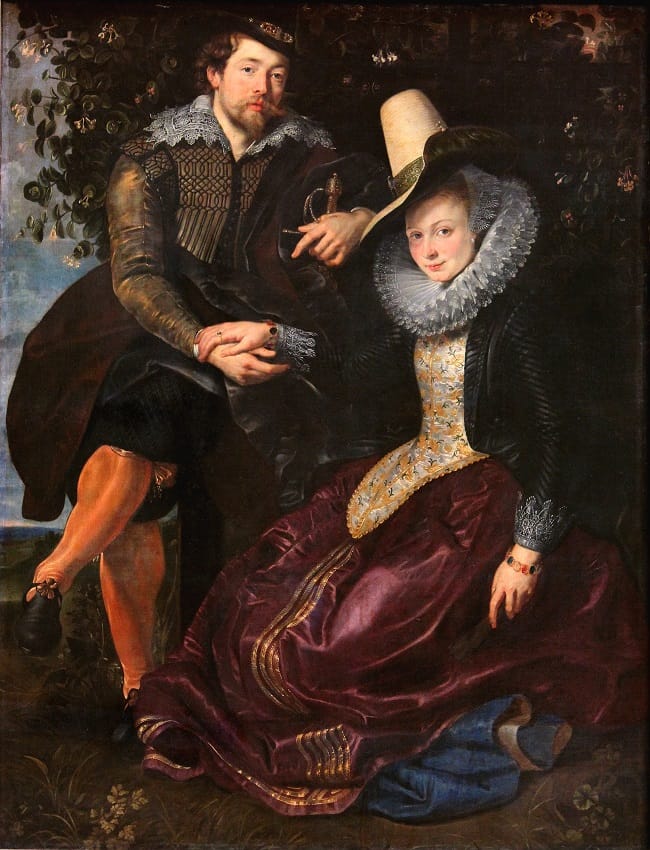
Rubens was 32 years old when he married 18years old Isabella Brant. Isabella was the daughter of the humanist and lawyer, Jan Brant one of the secretaries of Antwerp.
The painting shows a full-length double portrait of the couple seated in a bower of honeysuckle, symbolizing love and marriage that surrounds them.
The honeysuckle and garden were both traditional symbols of love and faithfulness.
Rubens depicts himself as an aristocratic gentleman with his left hand on the hilt of his sword, Each includes slightly towards the other.
The plants and trees in the garden are all flourishing. this double portrait broke new ground in portrait painting. The traditional symbolism blends with a scene expressing middle-class happiness, affluence, and affections.
Rubens is sitting with his legs crossed on a balustrade with his right hand, he supports the right hand of his wife.
She casts a friendly glance at the beholder Isabella is wearing a ruff, Florentine hat, and brocade bodice, and in her left arm, she is holding a fan.
Rubens’s orange hose complements her rich-red skirt.
Isabella Brant (1609-1626) died at the age of 34 years from Bubonic Plague, Seventeen years after this beautiful painting.
In 1630, four years after the death of his first wife Isabella, the 53years painter married the 16 years old Helene Fourment.
Helene inspired the voluptuous figures in many of his paintings from the 1630s. Rubens had eight children, three with Isabella and five with Helene. His youngest child was born eight months after his death.
Couple Kissing Art “The Kiss” by Gustav Klimt
The famous kiss painting lives inside the Belvedere museum in Vienna, Austria. And it’s perfectly square, measuring nearly six feet on each side.
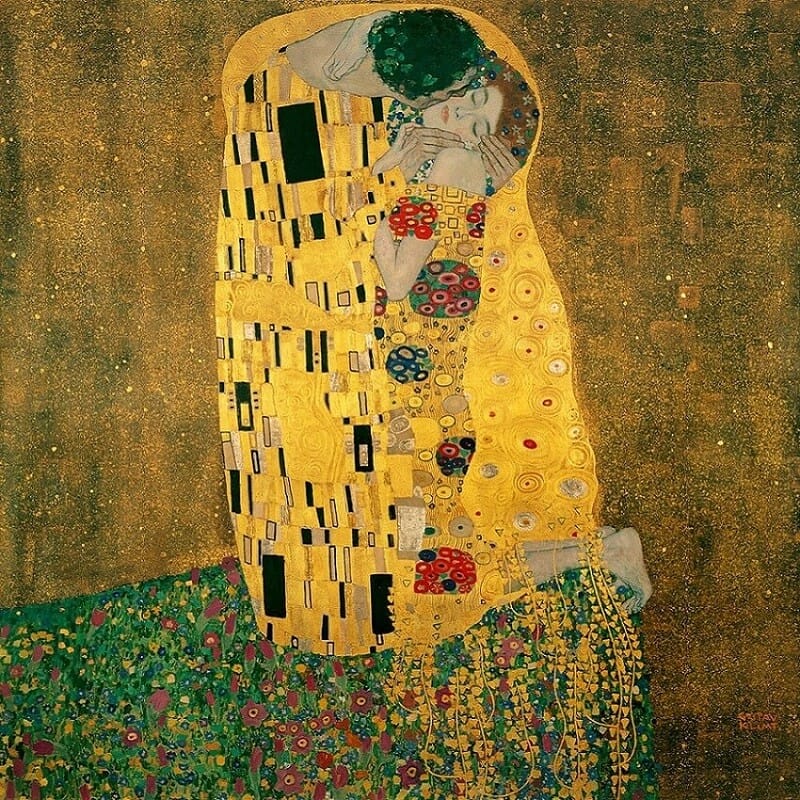
Gustav Klimt romantic paintings are the most expensive painting gift in the world when it was purchased for 240 thousand dollars over 100 years ago.
One Of her hand’s curls around his and the other drapes around his formidable neck. They both are surrounded by beautiful flowers on the edge of a hill, her feet curled over the edge.
The woman has shown a cool face her expression is a mixture of rapture and acquiescence Klimt draws distinct visual differences between the man and woman. the woman wears a wreath of flowers in her hair.
The man or wreath of Laurel a symbol of achievement or conquest the man’s robe is a pattern of white grey and black rectangles.
The woman’s garb is made up of a grouping of colorful concentric ovals compositionally it’s unique and daring in a couple of ways first, the campus is a perfect square.
The Birthday by Marc Chagall
Marc Chagall, an orthodox Jew, was born in Vitebsk, Russia on the 7th of July 1887 as Moshe Segal.
He was the eldest of 9 children. His father worked for a fish merchant, his mother ran a grocery shop and rented out small wooden huts built onto the side of the family house for extra income.
As a boy, he attended the Jewish primary school and the Municipal School in Vitebsk.
Later in life, he described Vitebsk as ‘a strange town, an unhappy town, a boring town,’ yet it features in many of his paintings.
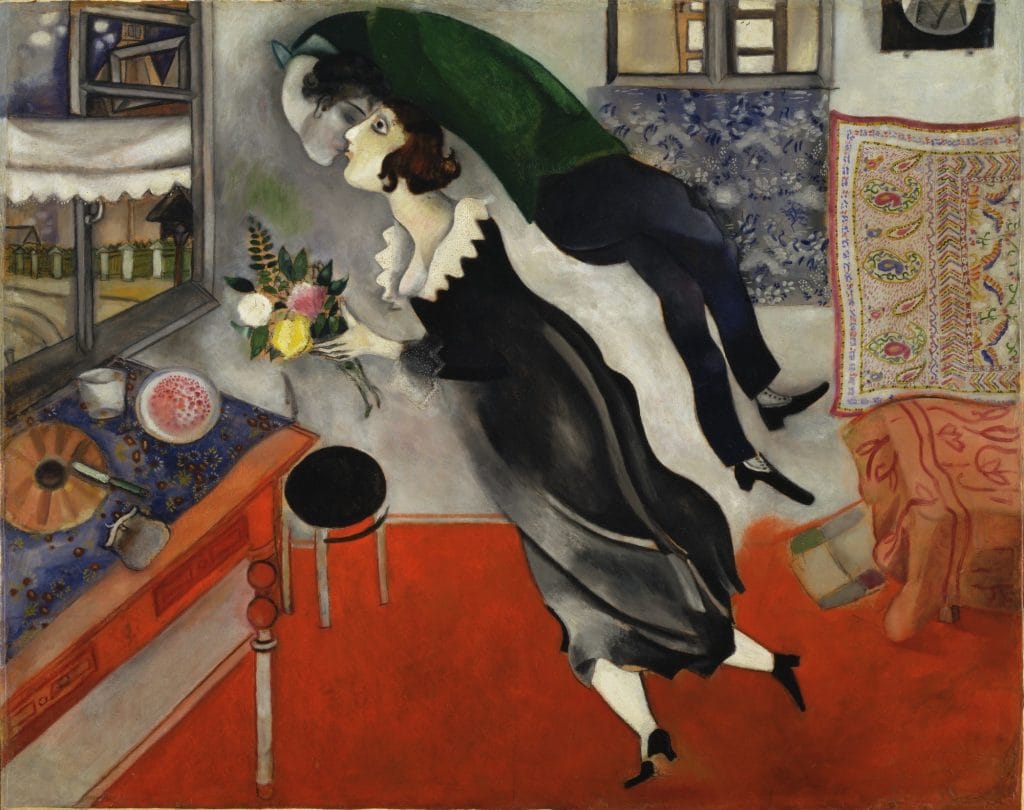
At the age of 18, Chagall started at the art school of the painter Yehuda Pen, but he left after 2 months to work as a re-toucher for a Vitebsk photographer.
Later, in 1907 Chagall moved, without a permit, to Saint Petersburg to take up an apprenticeship as a sign writer.
He lived there in great poverty, but soon joined the painting school of the Imperial Society for the Promotion of the Arts.
On the 25th of July 1915, Chagall married Bella Rosenfelt in Vitebsk despite the opposition of his parents. who wanted a better match for her daughter.
The Birthday painting was painted a few weeks before they got married. the painting is a wonderful expression of the amazing powerful love they two shares.
Chagall is pictured flowing in a dream light floating above Bella. His head unrealistically claimed upside down and backward. He twists around to kiss his future wife.
Bella is depicted holding a cheerful bouquet in her hand and floating in the air as just lifting off. The painting is a marvelous creation that powerfully conveys the feeling of your love between young lovers.
Two teenagers madly in love with each other that is what we see in Springtime, painted in 1873 by Pierre Auguste Cot, or as some people pronounce Pierre Auguste Cot. Pierre Auguste Cot was a French artist born in 1837.
Seated on a swing, these two teenagers look each other in the eyes. Her arms wrapped around his neck and only having attention for each other.
These teenagers, maybe young adults, found a romantic spot in the forest to enjoy each other’s presence. They are seated on a large swing that seems to come down from heaven.
And while, at first, they do not seem to be in full swing, the wind in the girl’s dress suggests otherwise; as if the artist captured them at a frozen moment in time, in the middle of their swing.
But this painting is not titled The Swing, which would seem the most logical title instead, it’s called Springtime. We can see some birch trees and butterflies in the background, as well as daisies, irises, and a small pond in the foreground.
But all these elements only form the décor for the couple on the swing. The boy gazes at the girl and she returns that with a coy smile. Both of them have one of their legs playfully tucked behind the other one. But whereas this all sounds like flirtation, it is the girl’s revealing dress that changes the feel of this painting.
It adds a sense of eroticism. Combined with the classical outfit of the boy, it results in an interesting mix of a classical painting, in which Greek and Roman’s goddesses were often depicted in similar ways and a response to the prudery of the Victorian era that influenced the world during the second half of the 19th century.
Seven years after Cot painted Springtime, he painted a pendant work called The Storm. It has comparable dimensions and shows the same young couple. Both works are on display in the Metropolitan Museum of Art.
The Storm was commissioned by an important patron of the MET Museum, named Catharine Wolfe. She was the cousin of John Wolfe who was, at that moment, the owner of Springtime. Catherine Wolfe had seen Springtime in her cousin’s apartment and decided to commission Cot to paint a comparable work, which would become The Storm.
In this painting, the teenage lovers run for shelter in a rainstorm, using the girl’s overskirt as an umbrella. It shows the same couple, dressed in similar clothes, possibly moments after a rainstorm arrived while they were sitting on the swing. Cot exhibited this painting in 1873 at the Paris Salon, the biggest art exhibition in the world.
Painting received a lot of attention at the Salon. The reactions of the art critics were not very enthusiastic about the daring nature of this painting. But the public was very enthusiastic about it, and the work was sold to the wealthy American hardware magnate John Wolfe, whom I mentioned earlier.
Cot was not the first artist to paint a sewing-themed painting. It was a subject that was attractive to other artists as well. The main reason for that is that the swing provided a natural element of movement in a painting, making the work livelier than other landscape scenes.
The most famous version of The Swing is by Jean-Honoré Fragonard, who painted this work in 1767 in typical Rococo style. It is a naughty painting, where the elegantly dressed woman on the swing is kicking her leg up such that the man hiding in the bushes can have a lookup into her billowing dress.
The Swing by Jean-Honoré Fragonard
These Greatest romantic paintings commissioned by a member of the French royal court, who asked Fragonard to paint his lover on a swing, being pushed by a bishop, while he hid and looked up his mistress’s dress.
By the time Fragonard takes on the commission and renders it, the bishop is no longer a bishop, just an older man, but he’s barely visible in the lower right. So this is a painting that was from the outset meant to be playful, erotic, sexually charged, that was a bit too naughty to be publicly displayed.
Like many Rococo paintings, it was a private commission, it was for a private home, and it was for a member of the aristocracy.
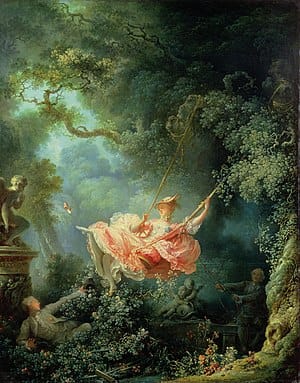
This is a transitional moment in Fragonard’s career. He had been known for large-scale, very formal history paintings, and it’s just at this moment when he’s abandoning that kind of career for private patrons outside of the system of royal commissions.
In that system of royal commissions for the academy, history paintings were primary, scenes from mythology, from French history, from ancient Greek and Roman history, so this couldn’t be more different.
It wasn’t just the subject that changed in Fragonard’s art, it was also his technique. His private commissions tended to be created quickly, with rapid brushwork, and we see that here. Look, for instance, at the edging of the woman’s dress. Part of the energy that that dress achieves is a result of the rapid brushwork.
You can see the oil paint, for example, in her bodice, or the white lace. And the idea of secretive eroticism is built into this painting symbolically, if you look at the left edge, you see a painting of a sculpture.
This is by a Rococo sculptor named Falconet, and is known as “Menacing Love.” And you can see that the Cupid has his finger up as if asking us to keep a secret.
Below that, we see a lovely relief sculpture that looks like maenads or nymphs dancing, and that’s not the only sculpture we see here. o the lower right, we see two Cupid figures that seem to be riding a classicizing dolphin, part of a fountain, and in fact, you can see the water spraying out towards the lower right of the painting.
But the star of the painting is the young woman, and, her fabulous pink silk dress, lined with lace, her bodice, her decolletage, her breasts, her choker, her hat, and to me especially, that pink slipper that she flips up into the air.
A way of understanding the Rococo is a style of art that comes out of the Baroque, but has jettisoned the seriousness, the morality, but has maintained its sense of energy, its sense of movement. Look at that swing, look at that forward momentum that carries the slipper off her foot.
And we know that the Baroque used diagonal lines to create a sense of movement and energy, and we see that here when we follow the rope of the swing through the female figure, and down to her lover in the lower left, who leans back on his right elbow, and lifts his left arm and seems overtaken by his love and desire for his companion.
She’s sitting on red velvet that’s got a gilded molding at the bottom of it. We’re not in the woods here. We’re in a cultivated, aristocratic garden, although an incredibly lush one.
Nature is so abundant and fertile here, it’s relating to the sensuality of the story, and couldn’t be more different than the spareness, the severity, the plainness that we’ll see in romantic paintings by David just a few years before the Revolution,
when we have an opposition to this type of subject matter, and when critics begin to call for an art that is very different, that offers a moral, instead of indulging in this kind of sensuality.
And because this painting becomes a foil to paintings by David with a style known as neoclassicism, the Rococo becomes a bit of a villain and is looked back to historically recently, by a Nigerian artist named Yinka Shonibare.
Who has created a three-dimensional representation of this painting, but that deals with not sensuality, but the costs of colonialism, but that is all hindsight. Fragonard’s “The Swing” is such a perfect expression of the frivolity, the luxury, and the indulgence of Rococo.
Sleeping Venus
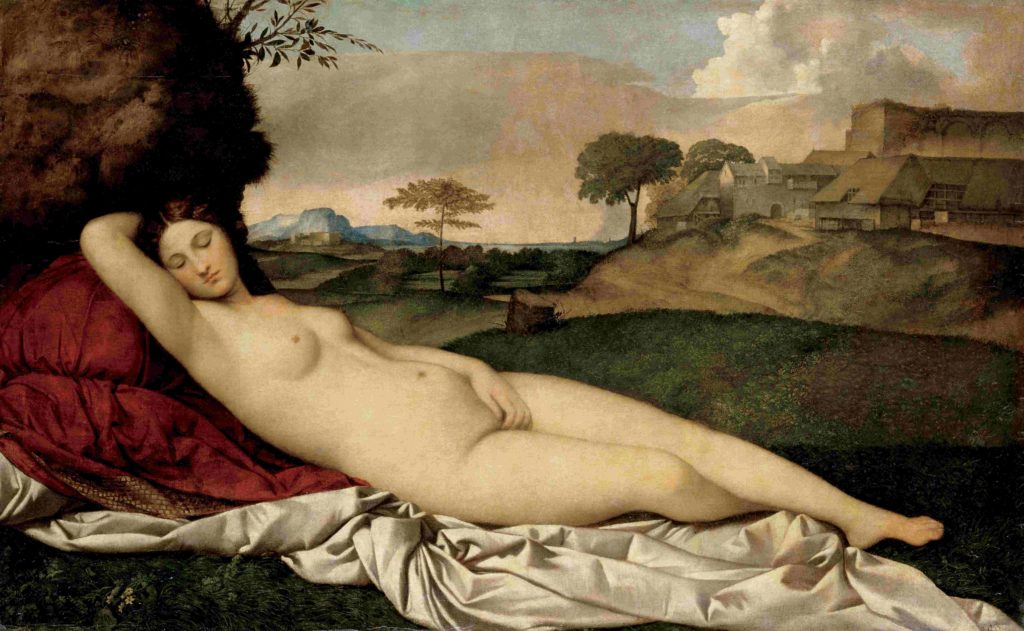
The Sleeping Venus romantic art by the Italian Painter named Giorgione. This oil painting represents a female nude body that seems to be an echo. Beautiful hills in the background.
It is believed that after Giorgione’s Death in 1510, Titian finished this painting.
Olympia

The beautiful romantic paintings are painted in 1863 by Edouard Manet is one of his top paintings.
In the painting, a servant brought flowers to the nude beautiful women laying on the bed. The artist described the beauty of women without clothes.
The theme of the painting is controversial which was first exhibited in 1865 becomes the world-famous romantic paintings.
After it was exhibited for the first time in Paris Salon and Government has taken extra safety measures to keep the painting safe.
To truly understand romantic art or greatest romantic paintings it is important to understand that these artists hope to share some of their deepest emotions through these works. whether the emotion was spiritual or dealt with physical gratification.
Whether the subject of historical love paintings was tangible or intangible, the artist aimed to glorify it, making it larger than life and supernatural. The objective was to draw attention to it, believed to be well-deserved.
Although Great Britain and Germany are considered strongholds of romantic arts, this era influenced artists and art critics worldwide.
The era of Romanticism open artist’s minds to themes techniques and styles that were less conventional and encouraged a highly personal approach.
